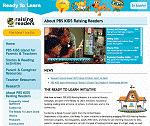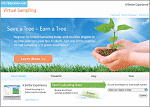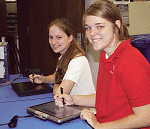Technology + Online + Industry + Partnerships
Digital Media Benefits Primary Prep
Research reveals that exposing preschool children to educational videos
and games helps them move on to K-12 with better literacy skills.
 A new study shows that educational videos
and interactive games can have a positive
impact on preschooler literacy when incorporated
into the curriculum in a classroom setting.
According to the study, children whose teachers
brought digital media into the classroom as part
of the Ready to Learn program came out more with more
advanced literacy skills and better prepared for
kindergarten than those who were not exposed
to such a program.
A new study shows that educational videos
and interactive games can have a positive
impact on preschooler literacy when incorporated
into the curriculum in a classroom setting.
According to the study, children whose teachers
brought digital media into the classroom as part
of the Ready to Learn program came out more with more
advanced literacy skills and better prepared for
kindergarten than those who were not exposed
to such a program.
The new study, "Summative Evaluation of
the Ready to Learn Initiative," was conducted
by Education Development Center (EDC) and SRI International on behalf of the Corporation for
Public Broadcasting (CPB). It
focused on economically disadvantaged children
in schools participating in Ready to Learn
programs in New York City and San Francisco.
Ready to Learn is an initiative funded in part
by the US Department of Education and is
operated by CPB, PBS, and the Ready to Learn Partnership. It
is designed to help improve literacy in students
ages 2 to 8 using a variety of media tools and
curriculum resources.
About 400 children in 80 classes from 47
different preschool centers participated in the
study. Teachers were randomly assigned a
10-week curriculum-- either literacy or science--
with those using the science curriculum serving
as the comparison group. Literacy teachers
were given training and support and were asked
to engage in "media-rich" activities with their
students during the study period, which ran
between January and June earlier this year.
Activities ranged from viewing PBS shows such
as Super Why!, Sesame Street, and Between the
Lions to playing web-based computer games
and participating in hands-on activities.
At the end of the 10-week period, children
who participated in the literacy curriculum
had more competent literacy skills than those
in the comparison group, outscoring them in
a statistically significant way in four out of
five measures: naming letters; knowing letter
sounds; recognizing letters in the student's
own name; and knowledge of "story and print
concepts," including reading left to right, identifying
the title of a book, identifying the author,
orienting the book correctly, and recalling its
major story points.
"Many studies have shown that computer
technologies can improve learning for students in
kindergarten through grade 12, but using digital
media in preschool has been controversial," said
lead researcher Shelley Pasnik, director of
EDC's Center for Children & Technology, in a
statement released to coincide with the report.
"To make these kinds of gains after preschoolers
and their teachers use technology, we think is
especially significant."
An executive summary of the research
and a complete copy of the report-- including
methodology and further explanation of other
aspects of the research-- can be accessed
online from EDC's site here. To find this article in its
entirety, along with a video about the Ready to
Learn initiative, visit here.
Green Spot
ED PUBLISHER DONATES TREES TO SCHOOLS
 Through its new Save-a-Tree
campaign, education publisher
Houghton Mifflin Harcourt plans to
give new trees to thousands of
schools across the nation. To
have the chance to win a tree to
plant on school grounds, educators
simply need to register for
the company's Virtual Sampling
service, an eco-friendly alternative
to traditional material sampling.
The service allows educators to
evaluate thousands of Houghton
Mifflin Harcourt's products online
instead of ordering printed samples
of the educational materials.
Winning schools will receive a
geographically appropriate tree in
a 100-percent recyclable
container.
Through its new Save-a-Tree
campaign, education publisher
Houghton Mifflin Harcourt plans to
give new trees to thousands of
schools across the nation. To
have the chance to win a tree to
plant on school grounds, educators
simply need to register for
the company's Virtual Sampling
service, an eco-friendly alternative
to traditional material sampling.
The service allows educators to
evaluate thousands of Houghton
Mifflin Harcourt's products online
instead of ordering printed samples
of the educational materials.
Winning schools will receive a
geographically appropriate tree in
a 100-percent recyclable
container.
The company is kicking off the
campaign this fall by selecting
1,000 educators who have
signed up for Virtual Sampling to
receive a tree for their schools,
and plans to give away more than
5,000 additional trees by spring
2010. Over the next few years,
Houghton Mifflin Harcourt hopes
to provide 20,000 trees to
schools through the Save-a-Tree
campaign. For more information,
visit here.
:: Industry News
NEW WEBSITE PROMOTES STEM
CAREERS FOR GIRLS. The nonprofit
Education Development Center has announced the
launch of a new, web-based STEM
(science, technology, engineering, and
math) resource called Girls Communicating
Career Connections (GC3). The online resource was
created by middle school girls and is
dedicated to sharing information about
science and engineering careers with
other middle school girls. The website
features a video series and activities that
share career information, encourage
21st-century skill development, and
discuss the positive impact of science
and engineering careers. There are also
companion resources for educators.
NETTREKKER RANKS SCHOOLS
FOR ONLINE SAFETY. NetTrekker recently released
its annual Safe Search Awards Index to
recognize school districts that
kept student internet searches
safe during the 2008-2009
school year. The districts were
broken down by size and ranked
according to the number of
safe searches their students
performed on the company's
educational search tool,
NetTrekker d.i. For the third
year in a row, Forsyth County
Schools in Georgia was ranked the top
large district, with more than 7.3 million
safe searches. Tangipahoa Parish
School System in Amite, LA, led the
midsize districts with 1,875,328 safe
searches, while Minnesota's Austin
Public Schools led all smaller districts
with 675,485 safe searches. The winning
districts received a prize package of
NetTrekker items and services worth
$5,000. Visit the NetTrekker website
for more information, including a
complete listing of schools on the
2008-2009 Safe Search Awards Index.
:: Awards and Contests
 DIMITROV NAMED AMERICA'S TOP
YOUNG SCIENTIST. Discovery Education and3M has honored
Marina Dimitrov from
Sacajawea Middle School in Bozeman,
MT, with the title of America's Top
Young Scientist. Dimitrov received the
honor as the winner of the 2009 Discovery
Education 3M Young Scientist
Challenge, an annual science competition
that encourages middle school
students to explore scientific concepts and communicate their findings. Dimitrov was one of 10 finalists chosen
from hundreds of students across the US to compete in a series
of live science challenges at the Metropolitan Pavilion in New York
City. As the grand-prize winner, she will receive $50,000 in US savings
bonds and a trip to 3M's global headquarters to meet with some of
the world's top scientists. For more details about the contest and this
year's results, visit here.
DIMITROV NAMED AMERICA'S TOP
YOUNG SCIENTIST. Discovery Education and3M has honored
Marina Dimitrov from
Sacajawea Middle School in Bozeman,
MT, with the title of America's Top
Young Scientist. Dimitrov received the
honor as the winner of the 2009 Discovery
Education 3M Young Scientist
Challenge, an annual science competition
that encourages middle school
students to explore scientific concepts and communicate their findings. Dimitrov was one of 10 finalists chosen
from hundreds of students across the US to compete in a series
of live science challenges at the Metropolitan Pavilion in New York
City. As the grand-prize winner, she will receive $50,000 in US savings
bonds and a trip to 3M's global headquarters to meet with some of
the world's top scientists. For more details about the contest and this
year's results, visit here.
DREAMBOX LAUNCHES VIDEO CONTEST. Educational software
company DreamBox Learning has kicked off its
Dream Big video contest for families and classrooms. The contest asks
children to use their imagination to create a video about what they
want to be when they grow up. Entries can be submitted individually
or by classroom on the DreamBox website until Nov. 30. The videos
will be posted on the website and on YouTube to
allow the public to vote for their favorites. A panel of judges will
review the most popular submissions and choose the top videos based
on content and creativity; winners will be announced on Dec. 15. All
entrants will receive a free one-month trial of DreamBox Learning's
online math adventure program, K-2 Math. Five entries will be awarded
six-month subscriptions to the program, three entries will win a
DreamBox Math Classroom license for the entire 2009-2010 school
year, and one grand-prize winner will receive $1,000 cash. To view
and vote for video entries, and read submission guidelines and rules
for the Dream Big contest, visit here.
 LOUISIANA SCHOOL
HONORED FOR LAPTOP
PROGRAM. The Lausanne
Laptop Institute of
Lausanne Collegiate School in Memphis, TN, has presented
its eighth annual Spotlight
School award to St. Joseph's
Academy in Baton Rouge,
LA. The annual award recognizes
K-12 schools whose laptop/tablet programs serve as international
models of innovation. St. Joseph's, an all-girls private high school,
was chosen for seamlessly integrating cutting-edge technology into
the learning environment and using it to support the teaching of
higher-order thinking skills. The school is among the first high schools
in the country to implement a 1-to-1 program that is fully supported
by a student-run help desk. You can read more about the school's
1-to-1 program in the March 2008 issue of T.H.E. Journal ("A Do-it-
Yourself 1-to-1 Plan").
LOUISIANA SCHOOL
HONORED FOR LAPTOP
PROGRAM. The Lausanne
Laptop Institute of
Lausanne Collegiate School in Memphis, TN, has presented
its eighth annual Spotlight
School award to St. Joseph's
Academy in Baton Rouge,
LA. The annual award recognizes
K-12 schools whose laptop/tablet programs serve as international
models of innovation. St. Joseph's, an all-girls private high school,
was chosen for seamlessly integrating cutting-edge technology into
the learning environment and using it to support the teaching of
higher-order thinking skills. The school is among the first high schools
in the country to implement a 1-to-1 program that is fully supported
by a student-run help desk. You can read more about the school's
1-to-1 program in the March 2008 issue of T.H.E. Journal ("A Do-it-
Yourself 1-to-1 Plan").